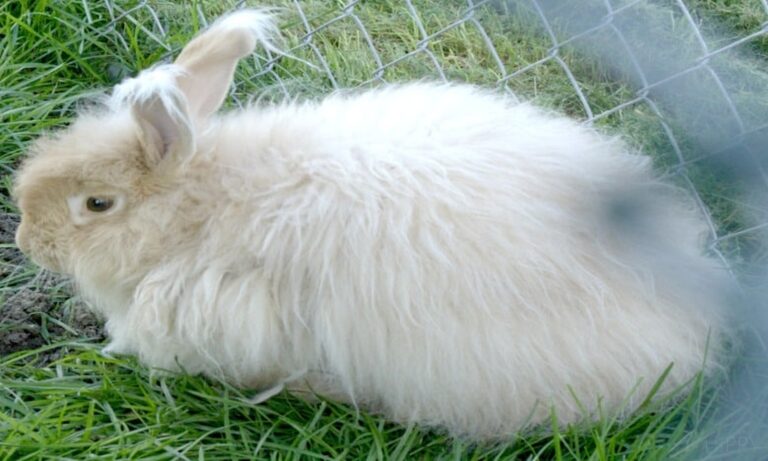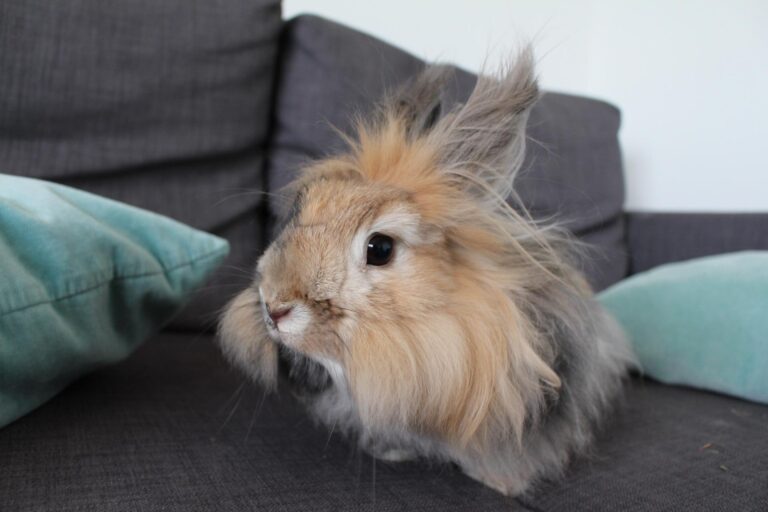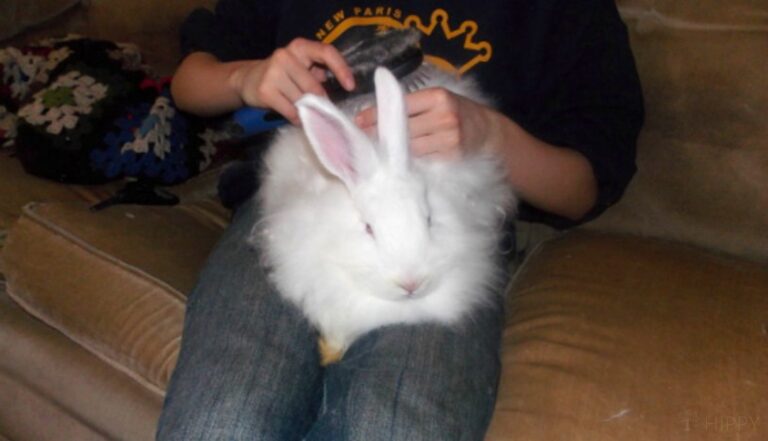What is soft, fluffy, makes very little noise and is a workhorse on the homestead? What is an easy pet to care for, even for smaller children and can be done by nearly any homesteader, including those in small areas?
What will provide you crafting wool once a year, and cause you to smile when you see them?

Benefits of Raising Fiber Rabbits
Raising fiber rabbits has many benefits.
For one, fiber rabbits are a sustainable source of fiber. They can provide enough fiber for a family to live comfortably without having to rely on synthetic fibers or being forced to buy from unethical suppliers.
Additionally, fiber rabbits can help to improve the soil in which they live. Their fur helps to aerate the soil and their droppings provide essential nutrients that help plants to grow.
Furthermore, fiber rabbits are relatively easy to care for. They are low-maintenance animals that do not require a lot of space or expensive food.
As a result, raising fiber rabbits is an excellent way to produce sustainable, ethical fiber while also helping to improve the environment.
Special Considerations When Raising Fiber Rabbits
When it comes to raising rabbits for their fiber, there are a few things to keep in mind. First, the diet of a fiber rabbit should be high in fiber in order to produce quality fur.
Second, these rabbits will need to be brushed regularly to prevent mats and tangles. Finally, fiber rabbits should be sheared once or twice a year to ensure that their fur remains in good condition.
With a little extra care, fiber rabbits can make excellent pets and provide their owners with plenty of soft, fluffy fur.
Fiber Rabbits Breeds
When raising rabbits for their fiber, it’s important to start with the right breed so you get the most bang for your buck (get it? Because a male rabbit is called a buck! I crack myself up).
While there are all kinds of rabbits you can raise for materials like cashmere, mohair, and more, the most popular rabbits are Angora rabbit breeds. Angora rabbit wool is some of the most beautiful you’ll find and in some cases, it’s easy to remove with plucking.
As someone who has raised sheep, I value this above anything else – sheep wool and the fiber from goats, even, are both beautiful and offer lots of warmth. But they take a lot of work to remove from the animal!
Not the case with rabbits. As long as you choose the right breed!
There are a few fiber rabbit breeds:
- French Angora,
- English Angora,
- Satin Angora,
- Giant (German) Angora.
French Angora
Many believe that the French Angora is great for beginners, because the guard hairs make up the coat instead of being more undercoated.
This makes the fiber easier to really get to. Pound for pound, however, the Giant Angora produces the most wool each year.
How much wool does an angora rabbit produce each year? Anywhere from 8 ounces to over 4 pounds, depending on specific fiber rabbit breed.
The Angora fiber price can be anywhere from $15-$45 a pound, making this a small money making venture.
English Angora
The English Angora is a popular breed of rabbit that is known for its beautiful, long wool. The breed originated in Turkey, and was brought to England in the early 1800s. Angora rabbits were first bred for their fur, but they quickly became popular as pets.
Today, they are still prized for their luxurious wool, which can be used to make a variety of garments and crafts.
English Angoras are relatively small rabbits, weighing between 4 and 5 pounds. They have large, floppy ears and a dense coat of wool. The wool is shed naturally, and does not require regular clipping.
English Angoras are gentle rabbits that make good companions. They are relatively easy to care for, and can live for up to 10 years with proper care.
Satin Angora
The Satin Angora rabbit is a popular choice for fiber production due to its soft, lustrous fur. The breed originated in France and was originally known as the Angora Satin.
The rabbits were bred for their unique coat type, which is different from the traditional Angora coat in that it has a satin sheen.
Statins are typically smaller than other Angora breeds and have a shorter coat. They come in a variety of colors, including white, black, blue, and chocolate.
The rabbits are typically gentle and easy to handle, making them ideal for spinning into yarn or other fiber products.
Satin Angoras are not as common as other Angora breeds, but they are gaining in popularity due to their unique coat type and gentle nature.
American Fuzzy Lop
For many years, the American Fuzzy Lop rabbit was bred primarily for its fiber. Unlike other breeds, the American Fuzzy Lop has a coat that is only partially covered in guard hairs. This gives the fleece a softer feel and makes it less likely to mat or feel.
As a result, the American Fuzzy Lop is an ideal breed for those who want to spin their own yarn or make other hand-crafted items. In recent years, however, the American Fuzzy Lop has become popular as a pet.
Thanks to their gentle nature and playful disposition, these rabbits make great companions. They are also relatively easy to care for, as they do not require regular grooming.
If you are looking for a pet that is both practical and adorable, the American Fuzzy Lop rabbit may be the perfect choice for you.
Giant Angora
The Giant Angora is a very old breed of rabbit, originating in Turkey. They are known for their beautiful, long wool, which can be used to make a variety of items including sweaters, hats, and blankets.
Angora wool is extremely soft and lightweight, making it a popular choice for those with sensitive skin.
In addition to being raised for their fiber, Giant Angoras are also popular as show rabbits and pets. They are generally gentle and good-natured, and they have an lifespan of 8-12 years.
While they do require regular grooming to keep their fur from matting, many people find the companionship of a Giant Angora to be well worth the effort.
Jersey Wooly
The Jersey Wooly is a popular breed of rabbit that was developed in the 1980s. The breed is known for its dense, fluffy coat, which is ideal for producing fiber.
In fact, Jersey Woolies are often raised specifically for their fiber, which can be used to make yarn and other textile products.
The breed is also known for being relatively docile and easy to handle, making them a good choice for those who are new to raising rabbits.
Overall, the Jersey Wooly is an excellent breed of rabbit with a variety of benefits.

How to Raise Fiber Rabbits
Learning to raise fiber rabbits, such as French Angora rabbit can bring you lots of wool for making hats, scarves, mittens, and even blankets.
Angora rabbit care is easy, but will need some extra steps over a meat or pet rabbit.
Grooming Your Rabbits
Fiber rabbits are primarily raised for their hair, and hair can get long or matted. Brushing it at the minimum of bi-weekly will help keep loose hair and mats off the rabbit.
When the hair gets matted, their poop and urine can get stuck to it. It will also build up in the cage. Both cases can be very harmful to the rabbit and can be difficult to clean.
Bathing the rabbit usually isn’t necessary, especially in cold weather. They can get very cold quickly, taking a long time to warm up. It’s better to keep the rabbit brushed and wash the wool as you clip it.
Keeping nails trimmed on a fiber rabbit is the same as any pet rabbit. If nails get too long, they can get stuck on the cages, risking getting ripped off the hocks.
Rabbits can bleed profusely if that happens. When trimming, carefully clip just the tip a bit at a time. This is usually the “curve” in the nail.
If you nip the hock when trimming, apply gentle pressure to help stop bleeding. Adding plantain, or yarrow in a gauze pad will also aid in stopping the bleeding.
Of course, some breeds of fiber rabbits will also require shearing. To shear your rabbits, I highly recommend investing in high-quality gear – don’t try to do this with cut-rate equipment, especially if you plan on selling the fiber.
Harvesting the Fiber
When raising fiber rabbits, you will want to collect their hair fiber, or give them a haircut at least once a year. We have found the best time is late Spring, before it gets too hot.
To cut the fiber, you will simply take very sharp scissors, and follow along the rabbit’s body line. Don’t cut too close, or you risk cutting the rabbit.
Sometimes, it’s helpful to have a second person hold the rabbit and cover their eyes when you are doing this. That will help to calm the rabbit and keep them more still.
When to Harvest Fiber from Fiber Rabbits?
There’s not really a straight answer to this question.
When raising fiber rabbits, there are a few things to consider when it comes to harvesting their fiber.
The first is the type of fiber rabbit you have. Some breeds, like the Angora, will need to be sheared while others, like the Rex, will shed their fiber naturally.
The second thing to consider is the time of year. In general, it’s best to harvest fiber in the spring or fall, when the weather is milder and the rabbits are not molting.
Finally, you’ll need to take into account the age of your rabbits. Younger rabbits will have softer, finer fiber while older rabbits will have coarser, thicker fiber. With all these factors in mind, you can decide when the best time is to harvest your rabbits’ fiber.

Feeding Your Rabbits
Food requirements for fiber rabbits will be the same as other rabbits. High quality feed, timothy hay weekly for added fiber and a small treat once in a while will keep your rabbit happy.
You can also feed pellets for added protein for your bunnies.
Treats like apple or carrot slices should be kept to a minimum to keep the rabbit’s blood sugar in check. If blood sugar gets too high, they will get sick. Fresh water daily in a clean crock or bottle is also crucial to their health.
Common Health Problems with Fiber Rabbits
As with any animal, there are certain health problems that are more common in fiber rabbits.
Enteritis
One common illness that affects rabbits is enteritis, which is an inflammation of the intestine. Symptoms of enteritis include diarrhea, dehydration, and lethargy.
If left untreated, enteritis can be fatal. There are several things you can do to help prevent enteritis in your rabbits.
First, make sure they have access to plenty of fresh water and a healthy diet. Second, keep their living quarters clean and free of debris.
Lastly, take them to the vet for regular check-ups to ensure they are healthy and to catch any problems early on.
Snuffles
This is a condition that causes the rabbit’s nose and eyes to discharge mucus, and it can be caused by a number of things, including bacteria, allergies, or even stress.
While snuffles can be alarming, there are a number of things you can do to help your rabbit feel better.
First, make sure they have plenty of water to drink, as this will help to thin out the mucus. You can also create a humid environment for them by misting their cage with water or placing a bowl of water inside.
Finally, you’ll want to clean their cage regularly and make sure they aren’t exposed to any drafts.
Ear Mites
Ear mites are tiny parasites that live in the warm, dark environment of the ear canal. Left unchecked, they can cause serious damage to the ears, leading to infection and even permanent hearing loss.
While ear mites are most commonly found in dogs and cats, they can also infect rabbits.
Fortunately, there are a number of effective treatments available for dealing with ear mites in rabbits.
The most important step is to clean the ears thoroughly with a cotton swab dipped in mineral oil or white vinegar. This will help to remove any accumulated wax and debris, as well as any eggs or larval stage mites.
Next, apply a topical acaricide (a medication specifically designed to kill mites) to the inside of the rabbit’s ear using a cotton swab. Be sure to follow the instructions on the package carefully, as some products may be harmful if used improperly.
Entertainment for Rabbits
Toys such as wooden chew toys, or small stuffed animals can provide plenty of entertainment.
They need the wooden toys to keep their teeth grounded, and many fiber rabbits like to “cuddle” with the small stuffed toys.
Surprisingly, they do not chew up the toys, either. Our rabbits always seemed to have a favorite teddy bear they played with, and even mothered.
Breeding Fiber Rabbits
Before breeding fiber rabbits, it’s important to do your research. Knowing the difference between commercial and hobby breeds is essential, as is understanding the coat types.
Once you’ve selected the right breed for your needs, you’ll need to find a good quality buck and doe. The bucks should have strong pedigrees and the does should be healthy and have good mothering instincts.
When it comes time to breed, be sure to keep an eye on the does. If they become stressed, it can affect their health and the health of their offspring. After the kits are born, it’s important to handle them daily to get them used to human contact.
Housing for Rabbits
Getting the fiber rabbits off the wire cages is important to keeping their hocks healthy. Due to their large size, time resting on something solid will prevent sore hocks.
A plastic resting board sold in farm supply stores is great, but a piece of old carpet, or even a scrap of wood will suffice. Rabbits will chew on the wood, so make sure it’s non treated.
Rabbits should have plenty of space to run and explore. A small cage will not suffice; instead, rabbits need an enclosure that is at least four times their size when fully grown.
Additionally, the enclosure should include a hiding place for the rabbit to retreat to when feeling stressed or overwhelmed.
Final Thoughts
As you can see, taking care of fiber rabbits isn’t difficult at all. They are fun, friendly, and can be a great source of yarn for the knitter/crafter in your family.
Have you ever raised fiber rabbits? What breed did you raise?
last update on July 18th 2022

Heather’s homesteading journey started in 2006, with baby steps: first, she got a few raised beds, some chickens, and rabbits. Over the years, she amassed a wealth of homesteading knowledge, knowledge that you can find in the articles of this blog.
Learn more about Heather and the rest of the writers on this page.

Hi Heather and all my fellow hippies,
Does anyone have information about raising fiber rabbits in hot climates?
I’ll see what I can find for you!
We are beginning to raise meat rabbits this year and the angoras caught my eye. I always viewed them as mainly as pets. What do you do when you have collected a lot of fur? What next?